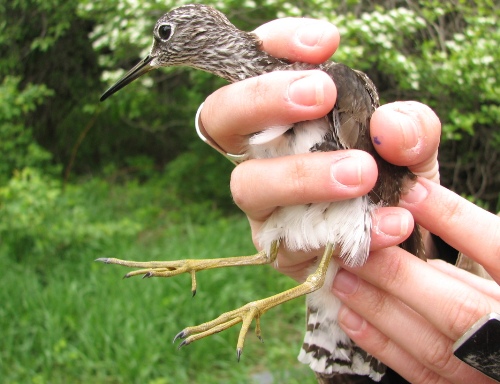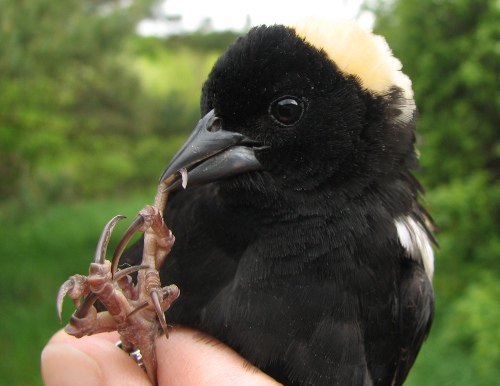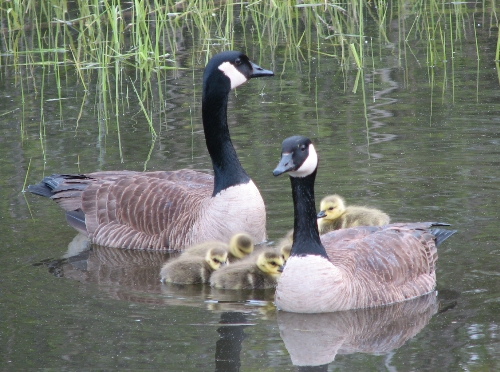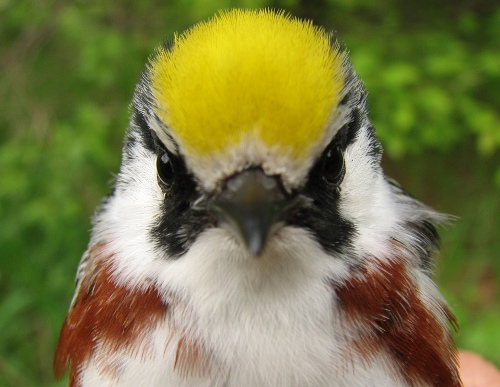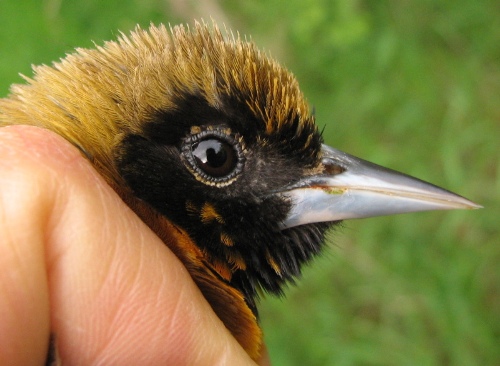|
McGILL BIRD OBSERVATORY |
||||||||||||||||||||||||||||||||||||||||||||||||||||||||||||||||||||
Welcome
to the McGill Bird Observatory weekly report.
Click here for a complete listing of our archives.
Banders-in-charge: Marie-Anne Hudson, Barbara Frei Notes: What a week! After we added two new species to the site list last week, it seemed like this week felt it had something to prove, as it served up two species banded for the first time! Numbers 104 and 105 are now assigned to Bobolink and Solitary Sandpiper, two species that have been zooming around our site for well over a week (as well as in past years) and that we had given up ever seeing in the net. Goes to show you should never give up! Ten species were added to the season/year list of species observed: Purple Martin, Sedge Wren, Swainson’s Thrush, Philadelphia Vireo, Red-eyed Vireo, Bay-breasted, Blackburnian, Canada and Chestnut-sided Warblers, and Indigo Bunting. Not to be outdone, 10 species were banded for the first time this season: Solitary Sandpiper, Hairy Woodpecker, Philadelphia Vireo, Black-throated Green, Tennessee, Wilson’s, Chestnut-sided and Magnolia Warblers, American Redstart, and Bobolink. The wind was definitely an issue with steady, strong south-west winds pretty much all week, finally resulting in an entire morning winded/rained out. We had 50 fewer net hours than last week, which might explain the 30 fewer birds banded, but actually had 150 more net hours than last year at this time, and only banded about 15 more birds. Though we can’t quite quantify it using net hours, we’re sure the winds kept the birds from flying as freely as they’d like to, resulting in fewer captures. It’s also likely that these southwest winds, so rare this spring up until now, may have encouraged migrants to zoom right over us and continue north, taking advantage of the strong tailwinds. Despite the slower pace this week, we’re still over 100 birds banded ahead of last year at this point in the season, and up four species. Aside from the very exciting Solitary Sandpiper and Bobolink bandings, there were many other highlights this week: our first Canada Goose family was seen paddling around the ponds, the avian morning chorus was finally loud enough to drown out our ever-persistent spring peepers, a mink zooming out of the J-trap as soon as it saw us coming took us a while to identify, the Tree Swallows taking advantage of every single horizontal surface to “get together”, leaving us with no doubt that eggs are coming, and our second group visit of the season, Rodger Titman’s wonderfully inquisitive morning chorus gang. This week’s top 10 banded species list shows a mixed trend, with some of the species that dominated last week's list continuing to show up in even greater numbers, while the departure of earlier migrants and arrival of some later ones has resulted in some new entries. White-throated Sparrows seemed to disappear overnight, accounting for their sudden departure from the list after dominating it for the past few weeks. However, just the fact they remained around in numbers for so long was a big contrast to past years - the 77 we banded over the previous four weeks alone nearly matches the combined total of 84 for the 2005-2007 spring migration monitoring programs. Just as the White-throated Sparrows vanished, we received a dramatic influx of Yellow Warblers, vaulting them to the top of this week's list, even ahead of the always numerous Red-winged Blackbirds. The number of Yellow Warblers we banded this week was greater than we had for the entire season either of the past two springs! Yellow-rumped Warblers hung in at third place, while the species in 4th through 6th all edged up in rank and number from last week. Three new additions round out our top 10, with Magnolia Warbler tied for 7th spot, Gray Catbird mewling into 8th and Rose-breasted Grosbeak coming in last. We’ve recaught several of the grosbeaks – they just seem to be everywhere at the moment! The major differences compared to last year at this time is the lack of Tennessee and Nashville Warblers. Perhaps they’re just a little later this year and will appear next week? Another interesting difference is the complete lack of Ruby-crowned Kinglets, five of which were banded last year at this time. Just goes to show how much push and pull there is in migration between years. The Canada Goose has finally been ousted from this week’s top 10 observed species list, with Yellow Warblers surging into 2nd position behind the ever-present Red-wings. The list is otherwise fairly stable, with the same species as last week juggled around a little. Two exceptions: Baltimore Oriole and Common Grackle have cracked the top 10, as they are now numerous enough - and other species have dropped in abundance enough - to allow them onto the list. As we count down the days until our Baillie Birdathon (this Saturday), we hope for another influx of species, good weather, and lots of laughs!
|

